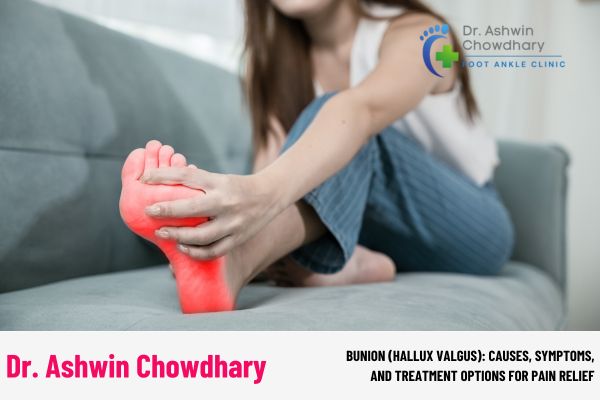Bunion (Hallux Valgus): Causes, Symptoms, and Treatment Options with Dr. Ashwin Chowdhary
A bunion (also known as hallux valgus) is a painful foot deformity that occurs when the big toe points toward the second toe, causing a bony bump to form at the base of the toe. This condition can affect your daily activities and mobility, but with the right approach, it can be managed effectively. Dr. Ashwin Chowdhary, a leading foot and ankle specialist, explains the causes, symptoms, and treatment options for bunions.
What is Hallux Valgus (Bunion)?
Hallux valgus, commonly referred to as a bunion, is a progressive condition that causes the misalignment of the big toe joint. The big toe moves toward the second toe, which results in the formation of a bony bump on the side of the foot. Bunion deformities are often painful, particularly when pressure is applied to the joint, such as when wearing tight shoes.
Causes of Hallux Valgus (Bunion)
Several factors contribute to the development of hallux valgus, including:
- Genetic Predisposition: A family history of bunions increases the likelihood of developing them.
- Footwear Choices: Wearing tight, narrow, or high-heeled shoes places undue pressure on the big toe joint and can cause or worsen a bunion.
- Flat Feet: Flat feet or abnormal foot mechanics increase the risk of developing bunions.
- Arthritis: Conditions like rheumatoid arthritis can contribute to the development of bunions by affecting the joints and causing inflammation.
- Injury: Trauma to the foot or toe joint may lead to misalignment and bunion formation.
Symptoms of Hallux Valgus
The symptoms of a bunion can vary from mild discomfort to severe pain. Common symptoms include:
- A visible bump on the side of the foot at the base of the big toe.
- Pain or tenderness, especially when wearing shoes.
- Redness or swelling around the joint.
- Difficulty moving the big toe.
- Formation of corns or calluses due to friction between the toe and shoe.
As the bunion progresses, it may cause misalignment of other toes and make it difficult to find comfortable footwear.
Treatment Options for Hallux Valgus
The treatment for hallux valgus depends on the severity of the condition. Dr. Ashwin Chowdhary emphasizes that both non-surgical and surgical treatments are available to help manage symptoms and improve quality of life.
Non-Surgical Treatments:
- Footwear Modifications: Choose shoes with a wide toe box and avoid tight or pointed shoes to minimize pressure on the bunion.
- Padding and Cushions: Use bunion pads or orthotic inserts to protect the bunion and reduce friction.
- Ice and Elevation: Applying ice to the bunion can help reduce swelling and discomfort. Elevating the foot also improves circulation.
- Pain Relief: Over-the-counter pain relievers such as ibuprofen or acetaminophen can help alleviate pain and inflammation.
- Physical Therapy: Exercises to strengthen and stretch the foot muscles may help improve alignment and reduce discomfort.
Surgical Treatments:
When non-surgical methods fail to relieve pain or the bunion becomes severe, surgery may be recommended. Dr. Ashwin Chowdhary explains that the goal of bunion surgery is to realign the big toe and remove the bony bump. Common surgical options include:
- Osteotomy: A procedure where the bones of the toe are cut and repositioned to correct the alignment.
- Arthrodesis: Fusing the bones in the affected joint to provide stability.
- Exostectomy: Removal of the bony protrusion without realigning the toe.
The type of surgery depends on the size of the bunion and the patient’s overall health.
Conclusion
If you are suffering from hallux valgus (bunion) pain, seeking early treatment is key to preventing further deformity and improving your mobility. Non-surgical options like proper footwear and pain management can provide relief, but for more severe cases, surgical intervention may be necessary. Consult with a specialist like Dr. Ashwin Chowdhary to explore the best treatment options for you and regain pain-free movement.

